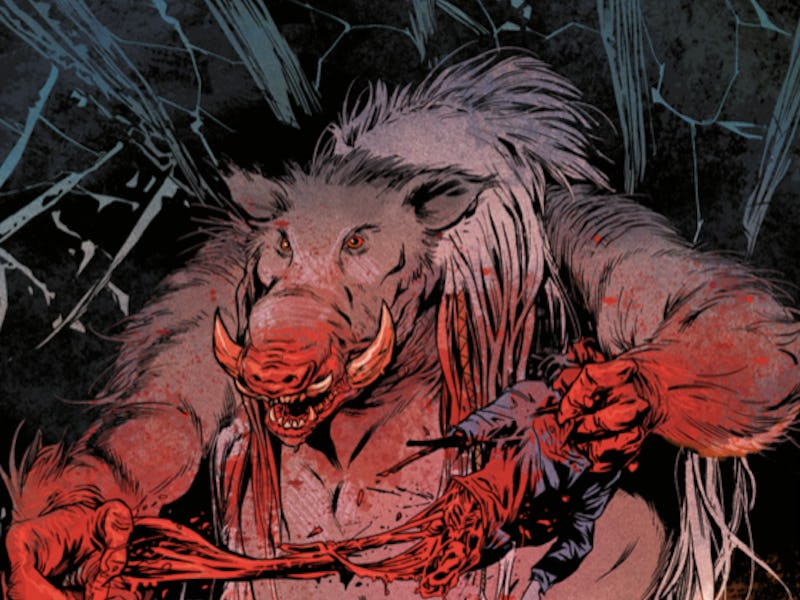Image's 'Cry Havoc' Tears Superhero Stories Limb From Limb
"Superheroes at their best when they're big, bold, fun metaphors for the chunkiest ideas in our world, dressed up in human-level dramas, squabbles and romances."

Si Spurrier, a British comics creator whose work in superhero fiction has included Judge Dredd and X-Man Legacy, wrapped his monster warfare drama Cry Havoc on June 22, with a sixth and final (for now) issue. The Cry Havoc trade paperback is available from Image for the first time this week, and to mark the occasion, Spurrier spoke with Inverse about his definition of heroism and the future of his incredible, ruthless monster story.
Spurrier believes that literary monsters are akin to mutants – à la X-Men – more so than other superheroes, because many superhero origin stories involve a personal choice. Cry Havoc, on the other hand, follows a woman named Lou who is infected with a mythical, monstrous were-creature gene, loses her girlfriend, and is manipulated into joining a task force in Afghanistan alongside other half-formed creatures.
“I guess the one obvious distinction [between Cry Havoc and superhero stories], if we’re talking specifically about X-book mutants,” Spurrier said, “is that, whereas many superhero stories give us handy access to stories about choice (i.e.: how one chooses to apply one’s skills and ambitions to the world), mutant stories offer some wonderful analogues to non-choice matters of identity.”
The extraordinary humans in Cry Havoc aren’t politely approached by a Dr. Xavier or Nick Fury character who request their enrollment in a team of vigilantes. Instead, Lou and her allies are forced into submission — not unlike a Suicide Squad — with the promise of having their abilities removed once the conflict in Afghanistan is over.
Spurrier and his team of artists (each working on a different time period in Cry Havoc’s story) make brutal, gory images out of animal impulses. The book is a beautiful and disturbing project, and Spurrier’s focus on social themes make Cry Havoc’s shocking imagery feel earned.
According to Spurrier, the gore and mythical reality in the book aren’t meant to be the most arresting parts of the comic. “Cry Havoc’s the sort of story that is more interested in the day to day breed of heroism,” he said. “For instance, I can think of nothing more heroic than someone having to deal with a mental illness, or a personality disorder, or any identity issue which makes a person feel dispossessed and at-odds with the neat, tidy, uncluttered society we’re all supposed to want.”
Though he’s worked in superhero fiction before, Spurrier says many modern superhero comics don’t feel organic or human, because their narratives are so divorced from what most readers experience.
“Unlike the thinly disguised god-analogues of Spandexia,” he says, knifing simplistic super-stories between the ribs, “our monsters and myths come from that hazier middle ground: ghostly traces of forgotten folklore, trying to stake out a claim on the shades of grey between extremes; to find a slice of relevance in a modern world. The war in Afghanistan, as riddled with complexities and not-what-it-seems forces as any conflict, is simply a cauldron for all these bloody, sexy, tormented impulses to bubble out into the open.”
One of the themes that marks most superhero comics, particularly X-Men, is the suppression — or the rising above — primal and reactionary urges. Characters like Magneto preach that mutant powers are a sign that humanity is obsolete, and the heroes of X-Men stories argue for control, training, and compromise with non-meta-humans. Spurrier’s Cry Havoc jams a shot of adrenaline into that binary, and it becomes something throbbing and monstrous. Do our powers define us if we didn’t ask for them? Does an exceptional person owe the world heroism, in order to earn their space?
So why the vitriol against stories of good and evil? Spurrier says they’re outdated. “With the heartfelt caveat that I’m a big fan of superhero fiction when it’s handled right, I tend to be quietly suspicious about the binary morality we tend to encounter in ‘hero’ stories. Humans who gain great power will immediately - so we’re told - devote themselves to Moral Goodness (which in practice means violent justice), or set out to conquer the planet.”
As Lou and the other creatures in Cry Havoc attempt to figure themselves out, the humans around them are pulverized, tortured and tossed aside. There’s a sick surge of excitement in watching Spurrier’s gigantic creatures make bloody pulp out of human soldiers. Most of that joy, Spurrier says, comes from setting up these super-powered, pseudo-mythical creatures for carnage and letting them loose. At the risk of being unforgivably cheesy, Cry Havoc lets slip the caped crusader dogs of war, and it’s gorgeous.
Cry Havoc is available in its entirety in trade-paperback from Image Comics.